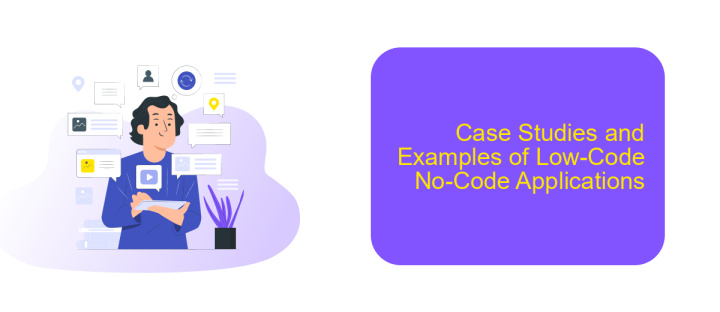Low-Code No-Code App Builder
In today's fast-paced digital landscape, Low-Code No-Code (LCNC) app builders are revolutionizing the way businesses develop software. These platforms empower users with minimal or no programming experience to create sophisticated applications quickly and efficiently. By democratizing app development, LCNC tools are bridging the gap between technical and non-technical teams, accelerating innovation, and reducing time-to-market for new solutions.
Introduction to Low-Code No-Code App Builders
Low-code and no-code app builders are revolutionizing the way applications are developed by enabling non-technical users to create functional software with minimal coding knowledge. These platforms provide a visual interface where users can drag and drop components to design and build applications quickly and efficiently.
- Ease of use: Intuitive interfaces that require little to no coding skills.
- Speed: Rapid development and deployment of applications.
- Cost-effective: Reduced need for specialized developers, lowering development costs.
- Flexibility: Ability to customize applications to meet specific business needs.
These platforms also offer integration capabilities with various third-party services. For instance, ApiX-Drive simplifies the process of connecting different applications and automating workflows without requiring extensive technical knowledge. This makes it easier for businesses to streamline their operations and enhance productivity. Overall, low-code and no-code app builders empower organizations to innovate and respond to market demands swiftly.
Benefits and Drawbacks of Low-Code No-Code Platforms

Low-code and no-code platforms offer significant benefits, including accelerated development timelines and reduced costs. These platforms empower non-technical users to create applications through intuitive interfaces, minimizing the need for extensive coding knowledge. This democratization of app development allows for faster iteration and deployment, enabling businesses to respond swiftly to market demands. Additionally, platforms like ApiX-Drive facilitate seamless integration with various services, further enhancing the efficiency and functionality of developed applications.
However, these platforms also have their drawbacks. Customization options may be limited, potentially restricting the scope and complexity of applications that can be developed. This can be a significant limitation for businesses with unique or highly specialized requirements. Additionally, reliance on a specific low-code or no-code platform may lead to vendor lock-in, making it challenging to migrate to other systems or technologies in the future. While these platforms are powerful tools, careful consideration is needed to ensure they align with long-term business goals and technical needs.
How to Choose the Right Low-Code No-Code Builder

Choosing the right Low-Code No-Code (LCNC) builder is crucial for ensuring efficient and effective app development. To make an informed decision, consider the following factors:
- Ease of Use: The platform should be user-friendly, with an intuitive interface that allows even non-developers to create applications effortlessly.
- Scalability: Ensure that the builder can handle the growth of your application in terms of users, features, and data.
- Integration Capabilities: Look for a builder that supports seamless integrations with other tools and services, such as ApiX-Drive, which can automate workflows and data transfers.
- Customization Options: The platform should offer a range of customization options to tailor the app to your specific needs.
- Support and Community: A strong support system and an active community can be invaluable for troubleshooting and learning.
By carefully evaluating these aspects, you can select an LCNC builder that not only meets your current requirements but also scales with your future needs. This will ensure a smooth and efficient app development process, saving both time and resources.
Case Studies and Examples of Low-Code No-Code Applications

Low-code and no-code platforms have revolutionized the way businesses approach app development, making it accessible to non-technical users. These platforms enable rapid prototyping and deployment, reducing the time and cost associated with traditional development.
One notable example is a retail company that used a low-code platform to create a custom inventory management system. This allowed them to streamline their operations without hiring a full development team. Another case involves a healthcare provider that built a patient management app, enhancing patient care through more efficient data handling and appointment scheduling.
- A financial services firm created a compliance tracking tool, ensuring they met regulatory requirements with minimal manual effort.
- An educational institution developed a student portal for managing coursework and grades, improving communication between students and faculty.
- A marketing agency leveraged a no-code platform to build a client dashboard, providing real-time analytics and performance metrics.
Integrating various services is also simplified with tools like ApiX-Drive, which enables seamless connections between different applications. This ensures that data flows smoothly across systems, further enhancing the functionality of low-code and no-code solutions.
- Automate the work of an online store or landing
- Empower through integration
- Don't spend money on programmers and integrators
- Save time by automating routine tasks
Future Trends and Innovations in Low-Code No-Code Development
The future of low-code no-code development is poised for significant advancements, driven by the increasing demand for rapid application deployment and the democratization of software development. One key trend is the integration of artificial intelligence and machine learning capabilities into low-code platforms, enabling more sophisticated and intelligent applications. Additionally, the rise of citizen developers—non-professional developers—will continue to grow, as businesses seek to empower employees across various departments to create and modify applications without relying on IT specialists.
Another exciting innovation is the enhancement of integration capabilities within low-code no-code platforms. Services like ApiX-Drive are leading the way by providing seamless integration solutions that connect various applications and automate workflows, making it easier for users to synchronize data across multiple systems. As these platforms evolve, we can expect more robust security features, improved user experiences, and expanded functionalities that cater to the diverse needs of businesses. The future of low-code no-code development promises to be transformative, making app creation more accessible and efficient than ever before.
FAQ
What is a Low-Code No-Code App Builder?
Who can benefit from using Low-Code No-Code platforms?
Can I integrate third-party services with a Low-Code No-Code App Builder?
Are Low-Code No-Code platforms secure?
What types of applications can I build with Low-Code No-Code platforms?
Routine tasks take a lot of time from employees? Do they burn out, do not have enough working day for the main duties and important things? Do you understand that the only way out of this situation in modern realities is automation? Try Apix-Drive for free and make sure that the online connector in 5 minutes of setting up integration will remove a significant part of the routine from your life and free up time for you and your employees.


